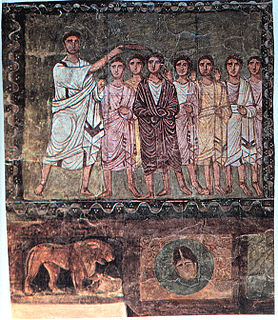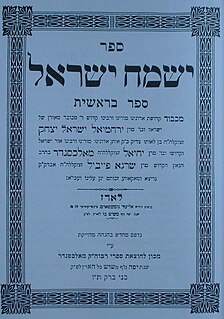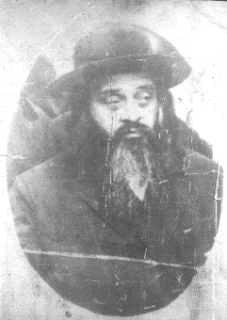
In Abrahamic religions, a messiah or messias is a saviour or liberator of a group of people. The concepts of mashiach, messianism, and of a Messianic Age originated in Judaism, and in the Hebrew Bible; a mashiach (messiah) is a king or High Priest traditionally anointed with holy anointing oil. Messiahs were not exclusively Jewish: the Book of Isaiah refers to Cyrus the Great, king of the Achaemenid Empire, as a messiah for his decree to rebuild the Jerusalem Temple.

The Messiah in Judaism is a savior and liberator figure in Jewish eschatology, who is believed to be the future redeemer of the Jewish people. The concept of messianism originated in Judaism, and in the Hebrew Bible a messiah is a king or High Priest traditionally anointed with holy anointing oil. However, messiahs were not exclusively Jewish, as the Hebrew Bible refers to Cyrus the Great, king of Persia, as a messiah for his decree to rebuild the Jerusalem Temple.

Shema Yisrael is a Jewish prayer, and is also the first two words of a section of the Torah, and is the title of a prayer that serves as a centerpiece of the morning and evening Jewish prayer services. The first verse encapsulates the monotheistic essence of Judaism: "Hear, O Israel: the LORD our God, the LORD is one", found in Deuteronomy 6:4. Observant Jews consider the Shema to be the most important part of the prayer service in Judaism, and its twice-daily recitation as a mitzvah. Also, it is traditional for Jews to say the Shema as their last words, and for parents to teach their children to say it before they go to sleep at night.

United Torah Judaism is an alliance of Agudat Yisrael, a Hasidic party, and Degel HaTorah, a Lithuanian Haredi party. Both are ultra-Orthodox political parties in the Israeli Knesset. It was first formed in 1992.

Nachman of Breslov, also known as Reb Nachman of Bratslav, Reb Nachman Breslover, Nachman from Uman, was the founder of the Breslov Hasidic movement.

Vizhnitz is the name of a Hasidic dynasty founded by Rabbi Menachem Mendel Hager. Vizhnitz is the Yiddish name of Vyzhnytsia, a town in present-day Ukraine.

Yeshiva Chofetz Chaim is an Orthodox yeshiva in the United States, based in Kew Gardens Hills, Queens, New York. It is primarily an American, Lithuanian-style Talmudic yeshiva. The Yeshiva is legally titled Rabbinical Seminary of America (RSA), however it is often referred to as just Chofetz Chaim, as that was the sobriquet of its namesake, Yisroel Meir Kagan. The school has affiliate branches in Israel and North America.

Yisrael Meir Lau served as the Chief Rabbi of Tel Aviv, Israel, and Chairman of Yad Vashem. He previously served as the Ashkenazi Chief Rabbi of Israel from 1993 to 2003.
Ani Ma'amin "I believe" is a prosaic rendition of Maimonides' thirteen-point version of the Jewish principles of faith. It is based on his Mishnah commentary to tractate Sanhedrin. The popular version of Ani Ma'amin is of a later date and has some significant differences with Maimonides' original version. It is of unknown authorship. Both Ani Ma'amin and a poetic version, Yigdal, form part of the prayers of Jews and have inspired varied settings to music.
Da'as Torah, is a concept in Haredi Judaism according to which Jews should seek the input of rabbinic scholars not just on matters of Jewish law, but on all important life matters, on the grounds that knowledge of the Torah aids everything in life.

The Aleksander hasidic movement flourished in Poland from 1880 until it was largely destroyed by Nazi Germany during World War II. The sect is named after the town of its origin, Aleksandrow Lodzki, Poland,, which was called Aleksander in Yiddish.

Elazar Menachem Man Shach was a leading Lithuanian-Jewish Haredi rabbi in Bnei Brak, Israel. He also served as one of three co-deans of the Ponevezh Yeshiva in Bnei Brak, along with Rabbis Shmuel Rozovsky and Dovid Povarsky.
A Moetzes Gedolei HaTorah is the supreme rabbinical policy-making council of the Agudat Yisrael and Degel HaTorah movements. Rabbis sitting on the various Moetzos are usually either one of the more prestigious Roshei Yeshiva or Hasidic rebbes who are also usually regarded by many Haredi Jews to be the Gedolim ("great/est") sages of Torah Judaism. Before the Holocaust it was the supreme authority for the World Agudath Israel in Europe.
Gadol or godol is a term used by religious Jews to refer to the most revered rabbis of the generation.

Chabad messianism, or Lubavitch messianism, generally refers to the passion among adherents of the Chabad movement regarding the coming of the mashiach or Moshiach (Messiah), and their goal to raise awareness that his arrival is imminent. In addition, the term also refers more specifically to the belief that Menachem Mendel Schneerson, Chabad's seventh leader, is the Messiah.
Rabbi Elimelech Szapira of Grodzhisk (1823–1892) was the leading Hasidic rebbe of his time in Poland. He was a chosid (follower) of the Rizhiner Rebbe. After the death of his father, the Sorof of Mogelnica, he assumed leadership of the chasidim, who eventually numbered ten thousand.

Rabbi Shalom Dov Wolpo, also Sholom Ber Wolpe, is a rabbi and an Israeli political activist. Wolpo is the author of more than forty books.
The Three Oaths is the popular name for a midrash found in the Talmud, which relates that God adjured three oaths upon the world. Two of the oaths pertain to the Jewish people, and one of the oaths pertains to the other nations of the world. The Jews for their part were sworn not to forcefully reclaim the Land of Israel and not to rebel against the other nations, and the other nations in their turn were sworn not to subjugate the Jews excessively.

Shlomo Chanoch Hakohen Rabinowicz was the fourth and last Rebbe of the Radomsk Hasidic dynasty. He was the eldest son of the third Radomsker Rebbe, Rabbi Yechezkel Hakohen Rabinowicz and great-grandson of the founder of the dynasty, Rabbi Shlomo Hakohen Rabinowicz, the Tiferes Shlomo. Under his leadership, Radomsk grew to be the third largest Hasidut in Poland, after Ger and Alexander. Rabinowicz built a network of 36 yeshivas across Poland and Galicia that enrolled over 4,000 students by 1939. He was murdered in the Warsaw Ghetto together with his entire family.
Keser Torah Radomsk, also spelled Keter Torah Radomsk, is the name of yeshivas and kollels in Israel and the United States affiliated with the Radomsk Hasidic dynasty. The name was originally coined for a network of 36 yeshivas in pre-war Poland founded by the fourth Radomsker Rebbe, Rabbi Shlomo Chanoch Hakohen Rabinowicz and led by his son-in-law, Rabbi David Moshe Hakohen Rabinowicz.












